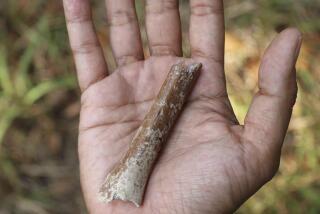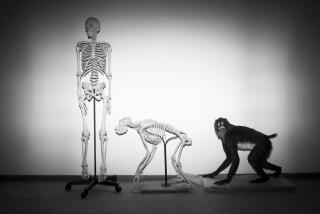Bones of New Human Ancestor Found in Africa
Along an ancient African lake shore, scientists have unearthed 4-million-year-old bones of a previously unknown ancestral human species, including perhaps the oldest direct evidence that humanity’s primitive predecessors walked upright.
Researchers in Kenya and the United States on Wednesday unveiled the jaws, teeth and bones of several individuals belonging to the new pre-human species. The fossils are the sole remains of creatures who stood on two feet at the evolutionary cusp between apes and humans, prowling 3.9 million to 4.2 million years ago near Lake Turkana in Kenya.
The newly discovered species combined apelike facial features, such as primitive jaws, ears and large canine teeth, with more modern human characteristics such as upright posture, paleoanthropologist Meave Leakey at the National Museum of Kenya said in a telephone interview from Nairobi. Her team gathered the fossils from two sites around Lake Turkana.
The new discovery pushes back by half a million years the earliest date when human ancestors are known to have walked upright on two legs.
“It is very dramatic,” Leakey said. “These specimens are answering questions that people have been raising for some time.”
The new species has been christened Australopithecus anamensis. It appears to be an intermediate step between the oldest known pre-human ancestor called Ardipithecus ramidus, which lived about 4.4 million years ago, and a short apelike human ancestor that lived several hundred thousand years later called Australopithecus afarensis, whose most famous representative is a partial skeleton known as Lucy.
With their discovery, Leakey and her colleagues have rekindled a fierce academic debate over the fundamental roots of the human family tree by raising the possibility that the ramidus fossils, hailed just last year as humanity’s oldest known direct ancestor, may instead have been an evolutionary dead-end.
The new fossils suggest that upright walking was such a powerful evolutionary innovation that it spurred the simultaneous development of many species of early hominids, as mankind’s pre-human ancestors are called, researchers said.
Some thrived in wooded glades, while others made their homes on the grassy savannas of ancient Africa. But only one of the apelike species eventually evolved into today’s Baby Boomers, Slackers and Generation Next.
The age of the anamensis bones raises the possibility that the more primitive ramidus hominids and the newly discovered species may have coexisted, with the older creatures dying out, the researchers said.
“They are suggesting that the very apelike characteristics of ramidus may mean that we are looking at a side branch and that it is not an ancestor,” said Donald Johanson, director of the Institute of Human Origins in Berkeley, who discovered the Lucy afarensis skeleton two decades ago.
Fossils of such ancient ancestors are so rare and the hints they offer of humanity’s dawn so tantalizing that many scientists spend their careers jousting over the proper interpretation of ancient teeth, bone chips and human dust. They all are seeking the clearest glimpse possible of the moment that humanity stepped out from the animal kingdom.
Asked about the team’s decision to categorize the bones as a new species, F. Clark Howell, an expert on human evolution at UC Berkeley, said: “I think they are right.” Howell is one of the few independent researchers who has examined the new fossils.
Other experts in humanity’s beginnings also hailed the newest discovery. William Kimbel at the Institute of Human Origins called it “critically important.” But many immediately began to worry at its meaning.
Could the new species be the ancestors not of modern human beings but of the great apes of contemporary Africa? Could the fossil fragments, exhumed from several sites, be the mixed bones of more than one species? Do the three early hominid species now identified lie on the same lineage, or are they just distant relatives?
“All these issues have to be considered and they are important, even if we lack the evidence to answer such questions at present,” said Peter Andrews, an expert on early apes and human origins at the Natural History Museum in London.
“In fact, it seems to me that this fossil raises more questions than it answers,” he continued. “And that makes it more interesting, not less.”
Scientists suggested these disputes may be soon settled by even newer fossil discoveries said to be emerging from the bedrock of East Africa, which cradled the birth of humankind.
An unusually complete skeleton of the ramidus species is said to have been uncovered in Ethiopia recently by Tim D. White, the UC Berkeley scientist who discovered the species in 1994. Details of that find await formal scientific publication, several researchers said. Other specimens of the new anamensis species are being recovered from the field as well.
The Leakey find is published today in Nature and is also featured in the September issue of National Geographic. The National Science Foundation and the National Geographic Society funded the work.
Meave Leakey belongs to a family that for several generations has earned world renown for key discoveries concerning the origins of humankind. She is the daughter-in-law of pioneer African fossil hunters Louis and Mary Leakey and the wife of conservationist Richard Leakey, who also has discovered some of the most well-known early human fossils.
Indeed, until now the best evidence that pre-humans walked upright was a unique trail of fossilized footprints discovered by her mother-in-law, which were left by three pre-human hominids walking through wet volcanic ash almost 3.6 million years ago.
Meave Leakey’s team, working in collaboration with biologist Allan Walker from Pennsylvania State University, exhumed nine fossil hominid bones in all from a site at Kanapoi just south of Lake Turkana and 12 specimens from Allia Bay to the north. Both sites are located on the rim of an immense ancient lake.
Fragments of a large shinbone found at the Kanapoi dig, which belonged to a creature weighing about 120 pounds, led the researchers to conclude that the primitive creatures walked standing up.
For example, the shape of the tibia bone--narrowing at its top where it would attach to the knee--suggests that it could bear more weight than the leg bones of a primate that supported most of its weight on its arms, like a modern chimpanzee. An arm bone--a humerus from a creature weighing almost 130 pounds--discovered at the site several years earlier seemed to confirm that conclusion.
But several researchers suggested this week that those two fossils actually may belong to a later species, such as afarensis. It is a challenge to date such ancient fossils precisely even under the best circumstances, and the Leakey group, working with fossils from different beds of rocks at two excavations, might have inadvertently included bones from more recent sediments with the older specimens, they speculated.
Walker bristled Wednesday at the suggestion that the arm and leg fossils were not properly dated.
“It is just not true,” he said, “that the tibia and humerus are later. Anyone who says that does not understand the geomorphology.”
Meave Leakey concurred. “I am perfectly confident that they are all from one time interval,” she said. “Our tibia shows us that our material was definitely from a bipedal walking animal.”
(BEGIN TEXT OF INFOBOX / INFOGRAPHIC)
New Man in Time
Researchers Wednesday announced the discovery of a new species of early human ancestor dating from about 4 million years ago. The find rekindles the debate over how humanity evolved.
Possible earliest hominid: 5.6 million years ago
Ardipithecus ramidus: 4.4 million years ago
****
NEW SPECIES
Australopithecus anamensis: 3.9-4.2 million years ago
Australopithecus afarensis: 3.0-3.9 million years ago
****
Homo neanderthalensis (Neanderthal)
Homo sapiens (Modern man)
Allia Bay: 12 fossil bones of the new species found here.
Kanapoi: Nine fossil bones of the new species found here.
The fossils unveiled Wednesday include a leg bone that some scientists believe is the oldest direct evidence that humanity’s earliest ancestors walked upright. They also raise the possibility that many species of prehumans thrived in East Africa at the same time, with only one evolving into modern humanity.
Sources: Nature, National Geographic, National Museum of Kenya
More to Read
Sign up for Essential California
The most important California stories and recommendations in your inbox every morning.
You may occasionally receive promotional content from the Los Angeles Times.










